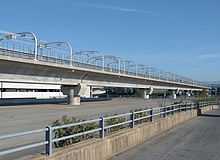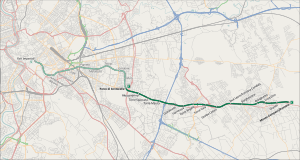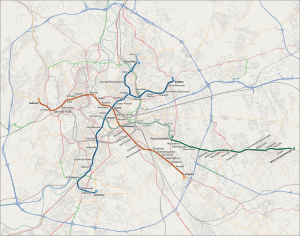Line C (Rome Metro)
| Rome Metro Line C | |||
|---|---|---|---|
 Elevated section of Line C close to its eastern terminus | |||
| Overview | |||
| Type | Rapid transit | ||
| System | Rome Metro | ||
| Locale | Rome, Italy | ||
| Termini |
Monte Compatri-Pantano (east) Parco di Centocelle (west) | ||
| Stations | 15 | ||
| Operation | |||
| Opening | 9 November 2015 | ||
| Owner | ATAC | ||
| Operator(s) | ATAC | ||
| Character | underground, at-grade and elevated | ||
| Rolling stock | AnsaldoBreda Driverless Metro | ||
| Technical | |||
| Line length | 12.7 km (7.9 mi) | ||
| Track gauge | 1,435 mm (4 ft 8 1⁄2 in) | ||
| Electrification | Overhead lines | ||
| |||
Line C is the third line of the metro system of Rome, Italy running von Monte Compatri-Pantano in the eastern suburbs of Rome to Parco di Centocelle (its current western terminus); it is also the first fully automated line in the city. The first section, between Monte Compatri-Pantano and Parco di Centocelle, opened on 9 November 2014; a further nine stations are currently under construction. As of 2015 the line is not yet connected to the other two metro lines in Rome. The line reuses parts of the old Rome-Pantano railway, a light railroad that is the last remaining part of the Rome-Fiuggi railway.
Construction
From August 2006 onwards archeological investigations took place before construction could start. The first construction sites opened in March 2007, on Piazza Roberto Malatesta, to construct Malatesta station. Lodi station followed one month later.[1]
In May 2008 two Tunnel Boring Machines were set up at Giardinetti,[2] and two months later the old Rome-Pantano railway was truncated at Giardinetti to allow restructuring part of the old surface line, which forms a part of the new metro. This stretch, from Montecompatri-Pantano to Parco di Centocelle, was inaugurated in 2014.[3] The section between Parco di Centocelle to Lodi will be opened in the first half of 2015, one further station (to San Giovanni) will be added in 2016. The part of Lince C leading further west is partly under construction (to Fori Imperiali-Colosseo with one further station in between) and is due to be opened in 2020. Planning for an additional station at Piazza Venezia is currently in the planning phase and funding is secured. The project planning for further extensions crossing the city centre (from Venezia up to Clodio-Mazzini) were suspendet in 2010.[4] A shortened extension to Ottaviano (thus providing a second interchange with Line A) is again under discussion.
In 2009, during preliminary excavations works for the station at Piazza Venezia (near the Capitoline Hill) remains of what has been identified as emperor Hadrian's Athenaeum were found.
Works on the different sections of Line C are supposed to be finished according to the following schedule:[5]
- 2015: Second section between Lodi and San Giovanni – currently under construction
- 2020: Third section between San Giovanni and Colosseo - currently under construction
Route
Currently (November 2014), the route is about 13 kilometers (8.1 mi) long and has 15 stations. Of the whole course, only 4 kilometers (2.5 mi) are underground, and the rest is in the open air.[6]
Originally the two planned termini were Pantano (a frazione of the comune of Monte Compatri) in the east and Clodio-Mazzini in the north, but in March 2007, a northward extension along the Via Cassia was announced, with nine more stations up to Grottarossa. A depot has been built at Graniti. The line will cross Line A at San Giovanni and at Ottaviano, and Line B at Colosseo. At Pigneto an interchange will be built with a new railway station on the FL1. At the Colosseo stop a public museum was to be constructed in the station to display archaeological material that was excavated during construction, but the project has been scrapped due to the lack of funds.[7]
The original plan featured a station, at Largo di Torre Argentina, in the city center. However, archaeological remains on the site were even more extensive than expected, and the station was cancelled.[8]
Extensions
The following extensions have been studied:
- northward (towards the railway ring around Rome, and the Rome-Viterbo railway, to which it would give access at Tor di Quinto; this extension would have five stations in all and would allow interchange with FL5 at Vigna Clara and Tor di Quinto;
- a southward extension of one station to Tor Vergata, where a secondary depot might be constructed;
- a northward extension of the east branch from Teano to reach Ponte Mammolo allowing interchange with Line B, with five new stations. This extension would also meet FL2 at Togliatti.
Rolling stock
The line is currently (November 2014) served by 5 AnsaldoBreda Driverless Metro convoys; once line C is completed, there will be 30 operational.
The metro depot of Line C, the Deposito di Graniti, which extends over 21,7 hectare is located between the station Graniti and the Eastern terminus Monte Compatri-Pantano.[9] It additionally serves as the maintenance and control center of Line C.[9]
References
- ↑ http://www.romametropolitane.it/Notiziario%20Cantieri/master%20Linea%20C.pdf Current situation of construction works. (Italian)
- ↑ http://www.metrocspa.it/diario_del_cantiere.asp Constructor's website (Italian)
- ↑ http://www.metroxroma.it/2013/09/linea-c-i-dettagli-dellaccordo-date-penali-prolungamenti/ (Italian)
- ↑ "La Linea C della metropolitana di Roma" (PDF) (in Italian). Metro C Spa. April 22, 2015. Retrieved April 30, 2015.
- ↑ http://www.metroxroma.it/2013/10/tratta-t3-avanti-tutta-fermarsi-costerebbe-180-mln/ (Italian)
- ↑ "I numeri della metro" (in Italian). Metropolitana di Roma. Retrieved 2012-09-27.
- ↑ http://ricerca.repubblica.it/repubblica/archivio/repubblica/2011/05/18/metro-niente-museo-alla-stazione-colosseo.rm_017.html
- ↑ http://www.metrocspa.it/il-percorso.asp
- ↑ 9.0 9.1 "Caratteristiche tecniche deposito di Graniti" (PDF). Metrocspa.it (in Italian). Archived (PDF) from the original on 2014-11-02. Retrieved 22 April 2015.
External links
![]() Media related to Line C (Rome metro) at Wikimedia Commons
Media related to Line C (Rome metro) at Wikimedia Commons
- Metro C on Roma Metropolitane - Official page (with map)
- Metro C Spa - the general contractor building the new line
| ||||||||||||||||||||||||

